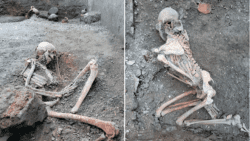Two men, thought to have been around 55 years old, were buried during an earthquake in Pompeii (Picture: Pompeii Archaeological Park/AP)
Victims of the devastating eruption by Mount Vesuvius almost 2,000 years ago weren’t just killed by volcanic ash and gas – earthquakes claimed lives too.
Archaeologists have discovered two skeletons buried beneath a collapsed wall in Pompeii, which was famously destroyed by the violent event.
The remains are believed to be men at least 55 years old, found in the insula of the Casti Amanti – a block of buildings comprising several houses and a bakery.
They were found beneath a wall that collapsed before the area was covered in volcanic material. The area was undergoing reconstruction work at the time of the eruption in 79CE, following an earthquake a few days earlier.
The eruption was one of the most deadly in history – but is also the most famous, due to the extensive preservation of its victims in the surrounding area.
‘In recent years, we have realised there were violent, powerful seismic events that were happening at the time of the eruption,’ said Gabriel Zuchtriegel, director of the Pompeii Archaeological Park.
The area where the men were found had already been damaged by an earthquake two days earlier (Picture: AP)
He added that new archaeological techniques and methodology had allowed them to ‘understand better the inferno that in two days completely destroyed the city of Pompeii, killing many inhabitants’, making it possible to determine the dynamic of deaths down to the final seconds.
More than 1,300 victims have been found in the archaeological site south of Naples over the last 250 years. Most are thought to have died from asphyxiation from the giant cloud of hot volcanic ash that enveloped the town.
Pompeii has provided a rich picture of the time around the eruption (Picture: AP)
New techniques are revealing even more information about the event (Picture: AP)
Last month, a team working at nearby Herculaneum discovered the first scorching current blasted from the volcano was so hot it turned victims’ brains to glass.
Since that deadly event Mount Vesuvius has remained active, including an eruption in 1906 that killed more than 100 people, and another in 1944 that destroyed nearby US Army Air Force planes deployed during World War Two.
MORE : DNA of doomed Pompeii victim sequenced for the first time
MORE : When Vesuvius erupted in 79CE, the first blast was so hot it turned victims’ brains to glass
It was a rough day.





